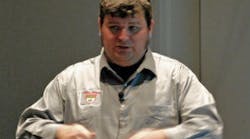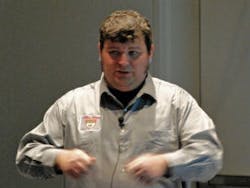"These solutions give us better data collection and display. We didn't have this luxury before. The old way took hours to extract data. Now, we can do it in minutes." Matt Fiedler of the City of Lima, Ohio, discussed the city utility’s recent upgrade of its wastewater treatment system.
When the U.S. Environmental Protection Agency (EPA) asked the City of Lima, Ohio, to reduce its discharges to the local Ottawa River to just five per year, the utility knew it needed to increase flow through its wastewater treatment plant (WWTP), and modernize its old control system with help from Rockwell Automation's PlantPAx process control platform.
"We service about 30,000 customers within our city limits, as well as other surrounding communities and several local businesses, including General Dynamics, Proctor & Gamble, Husky refinery, and many local hospitals and service industries," said Matt Fiedler, IT programmer and process control specialist, City of Lima. "All our water comes from four above-ground reservoirs with about 14.5 billion gallons of available water. In 1973, the plant was expanded to an average dry-weather flow capacity of 18.5 million gallons per day (MGD), with a peak flow of 53 MGD. Our latest project was upgrading the headworks at the front of the plant to support 70 MGD, as well as the DCS upgrade to achieve this flow."
Fiedler presented "Wastewater treatment modernization and digital transformation" at the Rockwell Automation Process Solutions User Group (PSUG) meeting before the opening of Automation Fair 2019 this week at McCormick Place in Chicago. This upgrade project was achieved with help from system integrator Commerce Controls Inc. (CCI) and Stratus Technologies.
Requirements drive goals
Fiedler reported that Lima's wastewater infrastructure also consists of 32 lift stations, three underground gate structures, five combined sewer overflow (CSO) structures, and five radio repeater sites.
"Our mandated goals from the EPA included decreasing CSO discharge events into the river to five per year; increasing WWTP capacity from 55 MGD to 70 MGD during peak wet weather; adding wet weather maximization at the plant level to treat as much as possible during big rain events; and upgrading our storm sewer overflow (SSO) basins," explained Fiedler. "Consequently, our process control goals were bringing our distributed control system (DCS) up to industry standards by replacing old 'spaghetti code' and streamlining our HMI screens; upgrading our remote lift stations with new PLC panels and radio telemetry; separating WWTP and WTP radio communications; replacing aging and failing PLCs at the WWTP; and creating a control standard that all future projects could follow."
In part due to his IT background, Fiedler reported that Lima also sought to upgrade its 20-year-old, fiber-optic network with a new ring, adopt a fault-tolerant server to maintain uptime, add new switches in its PLC cabinets, virtualize all new servers, add backup and recovery functions, and improve plant-level and network security. So far, the utility has implemented eight virtual machines (VM), nine Stratix switches, and an ftServer from Stratus, all for about $46,000.
On the infrastructure side, Lima is also building a 13-MG CSO basin, fixing underground CSO gates to regulate maximum flow, and rebuilding the head of its plant to reach its 70-MGD goal. Because its plant is landlocked, however, Fiedler added that the $46-million CSO basin and its three tanks are being built beneath an open field owned by the municipality. He reported this phase of the project is about three-quarters completed.
Radios, server aid software
To revamp its process control software and upgrade its communications, Fiedler added that, "We looked into our options, and settled on PlantPAx because it's an industry-standard that would let us get outside support, if needed. Plus, having one go-to supplier would help eliminate any cross-platform incapability, and would speed up integrating our hardware and software. We also went with Rockwell Automation's swing-arm conversions, which were quicker and saved on downtime."
In addition to PlantPAx, Lima deployed Rockwell Automation Factorytalk Historian software, FactoryTalk AssetCentre software, and FactoryTalk VantagePoint software. "These solutions give us better data collection and display," said Fiedler. "We didn't have this luxury before. The old way took hours to extract data. Now, we can do it in minutes."
Likewise, Fiedler added that Lima can collect and distribute data from its newly enabled wastewater system because it also upgraded its communications with GE MDS Orbit radios for telemetry. "They're also allowing us to run IP and serial communications with the old system until our conversion is complete, which makes getting the new stations coming online seamless," said Fiedler. "The new radios also allow us to work at home more. Instead of driving 40 minutes, working for 10 minutes, and driving 40 minutes back, we can now do many tasks in just 10 minutes."
Fiedler added that the foundation for all these upgrades is the reliable ftServer from Status that was adopted as part of the overall upgrade. "We'd looked at building a multi-server setup, but this wasn't best route because it could have been three times as costly," he explained. "We found that Stratus servers were a no-brainer because they had a smaller footprint, as well as better fault tolerance support. We went with the ftServer FT4710 after using the sizing tool, and it's allowed us to house our eight VMs, which include our domain controller and historian server.
"In the two and a half years sine we installed them, we've had zero issues, plus they give us an added layer of backup and recovery. We've increased security with the help of FactoryTalk's administration console. We're also adding security cameras and access control soon, and during rain events, the cameras will allow operators to monitor tanks without having to leave their station."






